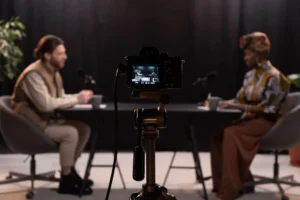Choosing a podcast recording software requires a bit of research to ensure you’re picking the best option for your show’s needs. From local and remote recording capabilities to be able to edit your audio in the same platform, we gathered the best podcast recording software to fit every type of show.
Before you’re ready to record your first podcast episode, check out our recommendations below then order the right recording equipment. In no time, you’ll have the perfect setup to capture quality audio on your first try.
But first, here’s what we look for an audio software to help podcasters start off on the right foot.
What To Look For In A Podcast Recording Software
Podcast audio software should not only capture crisp sound, it should also take care of the following things:
- Save files locally: Whether you’re recording episodes to an external device or sound card, the recording software should save the file locally to your computer. And while you’re at it, save it to more than one place to save yourself the headache of accidentally losing your raw recordings!
- Editing capabilities: For the podcasters who want an all-in-one tool, use a recording software that also lets you edit the file. Mix tracks, add sounds effects, and splice segments together all from one place. (Note: some of our recommendations don’t have editing capabilities. Check out our rundown of the best podcast editing software to complete your setup.
- Help and support: Use the software that matches your technological savviness. Make sure your tool of choice has the support you need to master its features. Whether it’s a library of video tutorials, real-time support representatives, or user forums, anything to help you succeed.
Action
Read to start your own podcast? Learn the nitty-gritty details of starting your own show in our comprehensive guide. Learn how to start a podcast.
Local Podcast Recording Software Recommendations
Local recordings are when you and your co-host or guest are all in the same room and you hit record. Each person speaks into their own microphone and is recorded on a separate track which are then stored locally in a central location. This recording setup allows for more control over the final sounding audio because you only have one recording environment to maintain and can fix any issues in realtime. There are many local podcast recording softwares to choose from but our top three are Audacity, QuickTime, and Adobe Audition.
1. Audacity
It’s a free audio editor for PC and Mac and a great tool for beginners. There are numerous effects you can add to your final audio files and plenty of installable plugins. We can’t say anything bad about this software–it’s free, functional, and well established. Another perk of Audacity is it’s an all-in-one tool. You can record live audio, immediately cut, splice, and edit it in one place then finally export your finished episode into different file formats.
The learning curve to master the tool is short, another benefit for new podcasters. To get you started, here’s a quick tutorial on how to use Audacity for your podcast recording software.
2. QuickTime
QuickTime is a software that comes with all Macs so you’re already one step ahead if you plan to produce your podcast with this Apple product. It’s a free, default application that allows you to record and export audio and video files to your computer and has an easy to use interface to boot. For a simple set up that doesn’t require much ramp up time to master, QuickTime is a great option.
3. Adobe Audition
For a more premium option that’s available for both Mac and PCs, Adobe Audition offers a few more bells and whistles than Audacity and QuickTime. For a little over $20 a month, you can record and edit your audio files within the platform. New podcasters also have the benefit of using their built in presets to set your audio settings to help you get started. The software offers single and multitrack recording, perfect for a podcast that includes locally recorded interviews or has a co-host. Due to the additional features, Adobe Audition has a higher learning curve to master so is better suited for seasoned podcasters.
4. GarageBand
GarageBand is an audio recorder and editor that comes standard on all Mac computers. While it’s geared more toward musical recording, it still works well for vocal-dominated podcasts.
GarageBand has a clean user interface and lets you edit and delete sections of your audio file or slide specific chunks of clip along your timeline to reorder segments. The addition of music overlays and sound effects, combined with visual equalization and compression, can increase the quality of your recording.
Remote Podcast Recording Software Recommendations
If your podcast features call-in guest interviews or your co-host lives on the opposite side of the country, you’ll need a recording software that supports remote recordings. While Skype was traditionally the software of choice for podcasters, a few new players have entered the space offering higher quality recordings across paid and free plans. These podcast recording softwares are perfect for beginners and veterans alike, so go with the one that best suits your remote needs.
1. Riverside
Riverside is a web-based recording tool that captures high fidelity audio AND video. It achieves one of the things you absolutely need in podcasting: multi-track recording. It records each person’s side of the conversation separately, stores the files locally on each person’s computer, and syncs them together. This way you can edit them separately and produce a superb overall recording. Riverside also works right within your browser so you don’t have to download additional software.
2. Squadcast
Another browser-based remote recording option, Squadcast is the newest software on the scene. Their tool focuses on capturing high quality audio and now includes mobile recording features which separates them from the pack. Another differentiating factor is their video capabilities so you and your guest or co-host can see each other as you record. Squadcast offers a flexible pricing model to fit a variety of podcasting needs and their team is committed to updating the platform to best serve the community.
3. Zoom
This is a free conference calling tool that’s great for conducting interviews. It’s free, but does have other paid options for additional features. Zoom is great because the connection is reliable and all you have to do is provide your guest with a link and they’ll be granted access to the chat room right from their browser. Whereas Skype cuts in and out, Zoom always delivers a great recording, even if your connection isn’t the most stable. This option also allows for multitrack recordings but you’ll need to remember to toggle on the “record on this computer” setting when you get behind the mic to store the audio locally.
4. Alitu
With Alitu, podcasters can record their interviews or co-hosted shows, and have them cleaned up automatically, from noise reduction to levelling, once the call is finished. Then, the recordings are popped directly into the Alitu episode builder where the host can edit the recordings, add intros, outros, adverts or transitions, and then export the episode.
They can then publish to the host of their choice. All in one place.




Comments are closed.